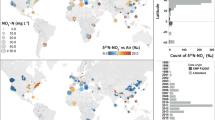Abstract
Human activities have increased the availability of reactive nitrogen in many freshwater ecosystems, leading to negative impacts on the health and biodiversity of lakes, rivers and wetlands. Yet, understanding the pathways of nutrient cycling in wetlands is limited. We conducted a nitrogen stable isotope (15N) tracer study to assess nitrogenous nutrient transfers within the biota community in a small experimental wetland between August 13, 2016, and September 12, 2016using a. Results showed rapid use of nitrogen by various aquatic plants and subsequent transfer to the consumer community. 15N enrichments were found in all plant samples from the first collection event. The fastest nutrient uptake was found in the simplest form of plants (periphyton and Lemna minor), followed by submerged macrophytes (Ceratophyllum demersum and Utricularia vulgaris). Emergent plants displayed the lowest 15N enrichment, likely due to their inability to directly assimilate nutrients from the water column and their initial large biomass. 15N enrichments in consumers were also pronounced, indicating that the nitrogen added to the wetland surface water was quickly transferred to various trophic levels. Primary consumers were more strongly labeled than secondary consumers; water column feeders were typically more enriched in 15N than benthic consumers. This experiment revealed different uses of nitrogen among the plant and consumer communities, and the results may provide useful information on community secession and ecosystem restoration under anthropogenic influence.






Similar content being viewed by others
References
Ashkenas LR, Johnson SL, Gregory SV, Tank JL, Wollheim WM (2004) A stable isotope tracer study of nitrogen uptake and transformation in an old-growth forest stream. Ecology 85:1725–1739
Axler RP, Reuter JE (1996) Nitrate uptake by phytoplankton and periphyton: whole-lake enrichments and mesocosm-15N experiments in an oligotrophic lake. Limnology and Oceanography 41:659–671
Barrón C, Middelburg JJ, Duarte CM (2006) Phytoplankton trapped within sea-grass (Posidonia oceanica) sediments are a nitrogen source: an in situ isotope labeling experiment. Limnology and Oceanography 51:1648–1653
Briers RA, Gee JH, Cariss HM, Geoghegan R (2004) Inter-population dispersal by adult stoneflies detected by stable isotope enrichment. Freshwater Biology 49:425–431
Chimney MJ, Pietro KC (2006) Decomposition of macrophyte litter in a subtropical constructed wetland in South Florida (USA). Ecological Engineering 27(4):301–321
Finlay JC, Small GE, Sterner RW (2013) Human influences on nitrogen removal in lakes. Science 342:247–250
Fry B (2006) Stable isotope ecology. Springer Verlag, New York
Galloway JN, Townsend AR, Erisman JW, Bekunda M, Cai Z, Freney JR, Martinelli LA, Seitzinger SP, Sutton MA (2008) Transformation of the nitrogen cycle: recent trends, questions, and potential solutions. Science 320(5878):889–892
Gu B, Dreschel T (2008) Effects of plant community and phosphorus loading rate on constructed wetland performance in Florida, USA. Wetlands 28:81–91
Li K, Liu Z, Gu B (2010) The fate of cyanobacterial blooms in vegetated and unvegetated sediments of a shallow eutrophic lake: a stable isotope tracer study. Water Research 44:1591–1597
Lin Q, Gu B, Hong J (2017) Tracking uptake of submerged macrophytes (Ceratophyllum demersum)—derived nitrogen by cattail (Typha angustifolia) using nitrogen stable isotope enrichments. Ecological Engineering 99:114–118
MacNeale KH, Peckarsky BL, Likens GE (2005) Stable isotopes identify dispersal patterns of stonefly populations living along stream corridors. Freshwater Biology 50:1117–1130
Middelburg JJ (2014) Stable isotopes dissect aquatic food webs from the top to the bottom. Biogeosciences 11:2357–2371
Scott DE, Yanes Y, Rothermel BB, Pilgrim M, Romanek CS (2015) Efficacy of labeling wetlands with enriched 15N to determine amphibian dispersal. Wetlands 35:349–356
Suddick EC, Whitney P, Townsend AR, Davidson EA (2013) The role of nitrogen in climate change and the impacts of nitrogen–climate interactions in the United States: foreword to thematic issue. Biogeochemistry 114(1–3):1–10
Tan Y, Li J, Cheng J, Gu B, Hong J (2013) The sinks of dissolved inorganic nitrogen in surface water of wetland mesocosms. Ecological Engineering 52:125–129
Tank JL, Meyer JL, Sanzone DM, Mulholland PJ, Webster JR, Peterson BJ, Leonard NE (2000) Analysis of nitrogen cycling in a forest stream during autumn using a 15N-tracer addition. Limnology and Oceanography 45:1013–1029
Vitousek PM, Aber JD, Howarth RW, Likens GE, Matson PA, Schindler DW, Schlesinger WH, Tilman DG (1997) Human alteration of the global nitrogen cycle: sources and consequences. Ecological Applications 7(3):737–750
Wozniak JR, Childers DL, Anderson WT, Rudnick DT, Madden CJ (2008) An in situ mesocosm method for quantifying nitrogen cycling rates in oligotrophic wetlands using 15N tracer techniques. Wetlands 28:502–512
Yu J, Li Y, Liu X, Li K, Chen F, Gulati R, Liu Z (2013) The fate of cyanobacterial detritus in the food web of Lake Taihu: a mesocosm study using 13C and 15N labeling. Hydrobiologia 710:39–46
Acknowledgments
This study was supported by the Science and Technology Commission of Beijing, China (grant # 08040900370000) and the National Natural Science Foundation of China (grant No. 41376158).
Author information
Authors and Affiliations
Corresponding author
Electronic supplementary material
ESM 1
(PDF 88 kb)
Rights and permissions
About this article
Cite this article
Hong, J., Zhang, J., Ma, Y. et al. The Fates of Nitrogen in an Experimental Wetland Food Web: a Stable Isotope Study. Wetlands 39, 303–310 (2019). https://doi.org/10.1007/s13157-018-1085-7
Received:
Accepted:
Published:
Issue Date:
DOI: https://doi.org/10.1007/s13157-018-1085-7




